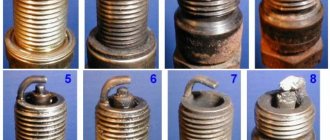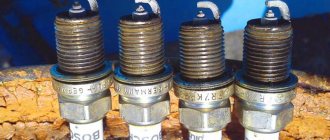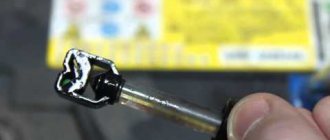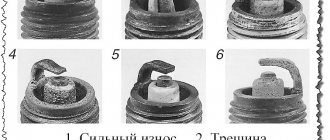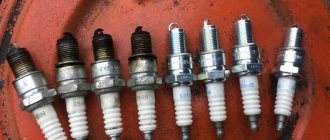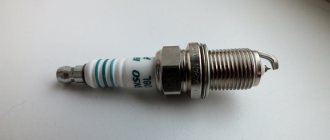Spark plugs perform the main function in an engine - they form a spark to ignite the mixture of fuel and air in the combustion chamber. The efficiency and quality of operation of this element of the ignition system determines the stability of the internal combustion engine, the ease of its starting, power, throttle response, fuel consumption, exhaust gas toxicity, etc. It should be borne in mind that spark plugs are a so-called “consumable”, that is, they must be changed periodically.
Experienced drivers are also well aware that the condition of the spark plugs during a check can determine not only the need to replace them, but also identify other malfunctions related to the operation of the engine and its systems.
We also recommend reading the article on how to check spark plugs for a spark on the injector. From this article you will learn about ways to independently check the spark plugs of an injection engine, as well as how to carry out such a check yourself.
Diagnosing spark plugs by the color of soot that accumulates on the electrodes and other parts makes it possible to determine the causes of such soot formation and the subsequent failure of the spark plugs themselves. In this article we will talk about what types of carbon deposits on spark plugs indicate various malfunctions and breakdowns of the internal combustion engine, why carbon deposits form on spark plugs, the reasons for the appearance of such deposits, and also how to clean spark plugs from carbon deposits at home.
Why does carbon deposits appear on candles?
The optimal period for using spark plugs is considered to be 60,000 kilometers. Professional auto mechanics advise replacing the element immediately after crossing this milestone.
With regular care and inspection of the vehicle, it is not always possible to avoid the appearance of a light coating on the surface of the product. The normal color of the top tip is considered to be a light gray shade. The occurrence of slight changes does not affect the performance of vehicles.
- Experts identify several reasons that can provoke such changes.
- The spark plugs inside the engine are designed to act as the ignition element that creates the spark.
- It promotes combustion of the fuel mass. The design of the mechanism implies the location of these elements next to the combustion chamber of the engine.
- When the engine starts, the surface of the spark plug experiences enormous loads.
- In addition, they are exposed to increased pressure, high temperature and various physical and chemical processes.
As a result, after some time, a grayish deposit appears in the lower section of the spark plug, on the surface of the insulator or electrode. Foreign particles are evenly distributed over the surface of the metal tip.
Depending on the type of problem with the car engine, the color palette of the spark plug tip may vary. Red, orange and black spots may appear around the perimeter of the body.
Timely diagnostics will allow you to avoid serious problems in the vehicle’s performance. First of all, it is recommended to pay attention to the state of the ignition timing or ignition timing.
Frequency of replacement of spark plugs and main causes of plaque
Spark plugs vary in type and destination; in the automotive industry, spark plugs are widely used, the lifespan of which is determined by the type of engine, the type of fuel for the engine and the recommendations of the manufacturer of both the car and the spark plugs. Spark plugs for engines running on reduced natural gas last no more than 10,000 km, while spark plugs for diesel engines should be replaced after 12,000 km, and for gasoline power units after 15-16,000 km, that is, every maintenance.
If problems arise with the engine, the first thing to do is to diagnose the spark plugs, because In 85% of cases, they are the most common cause of vibrations when driving and when the car slightly pulls to the side. You can diagnose the spark plugs yourself using the instructions for replacing spark plugs. By pulling out one of the spark plugs, you can determine by the plaque the type of problem existing in the car system, which is why the spark plug is unable to work properly. The following types of layering on candles are distinguished by color:
The color of soot is the color of the burnt impurity contained in the fuel. Ideally, natural impurities in good fuel are practically not deposited on the spark plugs, except perhaps in the form of light salt deposits, giving a slightly grayish color. It is worth noting that problems in the engine are determined not only by color, but also by the structure and density of carbon deposits (plaque).
Which color is not dangerous?
The performance of a gasoline engine directly depends on the condition of the spark plug electrodes. Their surface should be painted in a dirty brown shade, without traces of oil and soot elements.
If the surface of the spark plug is changed, it is recommended to carry out unscheduled technical diagnostics to detect the cause of such problems. Various parts of a gasoline engine can provoke such changes.
There are several color options that cover spark electrodes. These include:
- Grey;
- White;
- Terracotta;
- Red;
- Black.
The top of the spark plug may be covered with various deposits. Most often it is subject to oil deposits or a thick layer of soot. Such changes indicate serious problems with the engine.
Chemical method
It is no coincidence that car owners prefer to clean elements using a chemical method. Black carbon deposits from candles can be easily cleaned using conventional cleaning products designed for cleaning tiles and plumbing fixtures. Cleaning requires a small container, a rag and a toothbrush. Having prepared everything you need, follow these simple steps:
- Place the elements in a basin (bucket) and fill them completely with the prepared solution.
- Leave in the solution for 30 minutes (more is possible).
- Clean the element with a toothbrush.
- Rinse in running water and wipe dry with a cloth.
Before putting the elements in place, you need to dry them well. To do this, place them in the oven for 20 minutes or blow them with a hairdryer at minimum power.
Types of carbon deposits on candles
We propose to consider several situations to help understand the cause of these changes. For example, the vehicle has traveled a distance of over 25 km.
When unscrewing the spark plugs, we discovered that a light gray or terracotta tint had appeared on the surface of the electrodes.
The surface of the metal tip is undeformed and there are no traces of oil deposits. Such changes indicate the normal performance of the car. Minor changes indicate proper combustion chamber operation.
Similar shades are not always found. Many motorists, after unscrewing the spark plugs, discovered that the surface acquired the following color:
- Black;
- White;
- Red.
In addition to tint, the tip may be covered with traces of gasoline, automobile oil, ash, or corrosion. When simply inspecting spark plugs, it is important to determine the structure of the deposit.
For example, if black matte soot appears, then this phenomenon indicates contamination in the air filter area, improper fixation of the spark gap, a crack in the insulator, or improper carburetor adjustment.
The situation can be corrected by correct adjustment of engine operating processes, setting the correct spark gap, and replacing the igniting mechanism.
Mechanical cleaning method
The simplest cleaning method is to remove carbon deposits using sandpaper or a metal brush. Although this method is attractive in its simplicity, professionals do not recommend using it to clean black candles in order to avoid removing the thinnest deposit of precious metals applied to the electrode of the product. During mechanical cleaning of the SZ, it may be damaged. In addition, scratches form on the insulators, which leads to a much greater accumulation of soot.
Mechanical cleaning method.
Black carbon deposits on spark plugs
The occurrence of black soot is directly related to the contact of the metal tip and the air-fuel mixture. If before installation the surface was uniform or had a gray tint, then the appearance of a velvety black coating is directly related to the following reasons:
- Penetration of the oil mixture into the combustion chamber area;
- Low fuel quality;
- Multiple excesses of the permissible concentration of metal additives in gasoline;
- Malfunction of the cooling system;
- Problems with the ignition timing settings;
- Using low octane gasoline.
What to do if a dark-colored plaque appears? The first step is to familiarize yourself with the composition of the oil mixture and the condition of the piston rings. If the mixture is correctly selected, then you should pay attention to the fuel mixture.
After this, you can diagnose the cooling system and replace the spark plugs with new elements. When adjusting the ignition timing, it is recommended to pay attention to the recommendations of specialists. The fact is that an incorrect gap will provoke the occurrence of new faults.
Checking the condition of the power unit by carbon deposits
Automotive ignition elements remain a good diagnostic indicator if you need to identify problems with the ignition cycle of the fuel mixture. But you should not make an unambiguous conclusion about the condition of the power unit by inspecting the SZ after 25 or more than 1000 km of run. Diagnostics should be carried out exclusively on new products, after a short run-in (150-200 km).
Checking the SZ for the presence of black soot To check for malfunctions in the power unit by the soot formed, you need to:
- Supply new elements in accordance with technical specifications.
- Travel 200 kilometers with them.
- Remove the SZ and look at the shade of soot that appears on them.
Important! It is necessary to check the color of the deposits formed on the elements only on a warm engine.
White carbon deposits on spark plugs
The appearance of a white tint on the surface of the spark plug electrodes indicates a poor-quality composition of the air-fuel mixture. It is not recommended to use such gasoline in the future. The fact is that components in the fluid can cause new problems with engine operation.
When starting the engine, a disturbed combustion process is observed, which is accompanied by a large release of thermal energy. As a result, the combustion chamber overheats, thereby causing the metal tips and metal edge to melt.
Common mistake
To obtain a reliable result, the inspection must be carried out after the engine has been running for a long time. Otherwise, the inspection result will allow you to draw erroneous conclusions. Quite often there is a situation when drivers start a cold engine in winter and, hearing the sound of its uneven operation, turn off the spark plugs and turn them out.
Seeing black carbon deposits, they draw premature conclusions about the malfunction of the power unit, forgetting that black carbon deposits can form due to the fact that at subzero temperatures the working mixture is forcibly enriched, and due to the fact that the engine is not warmed up to the optimal temperature, it does not have time to burn completely . Unstable operation may well be explained by a malfunction of high-voltage wires that need to be replaced long ago.
Red carbon deposits on spark plugs
Redness of the tips on the spark plug appears when low-quality fuel is used. Some manufacturers resort to using chemical additives made from metal components to increase the octane number.
In general, the majority of the compounds are lead. When burned, the additives begin to quickly oxidize and uniformly cover the surface of the electrical contact with an orange or red coating.
- As a result, a disturbance in the sparking process is observed. In most cases, the engine may not start the first time.
- Additives in gasoline have a negative impact on other engine components.
It is recommended to change the fuel and carry out thorough diagnostics in the power plant area. Specialized equipment will allow you to accurately detect the source of the problem and select methods to eliminate it.
Possible reasons for the appearance of soot
Before answering the question of why the candles are black, you need to decide how exactly they turned black . After all, it depends on which direction to search. In particular, the candles can turn black all together, or maybe only one or two of the set. Also, the candle may turn black only on one side, or perhaps along its entire diameter. There are also so-called “wet” and “dry” carbon deposits.
It should be noted that the speed of appearance and nature of carbon deposits directly depends on existing faults (if any):
- Carbon deposits on new spark plugs begin to form after at least 200-300 km. Moreover, it is advisable to drive along the highway at approximately the same speed and engine load. This way the spark plugs will work in optimal mode, and it will be possible to more objectively assess the condition of the car’s components.
- The amount and type of soot depends on the quality of the fuel used. Therefore, try to refuel at trusted gas stations, and not drive with gasoline or similar mixtures. Otherwise, it will be difficult to establish the real cause of the appearance of soot (if it occurs).
- In a carburetor engine, the idle speed must be set correctly.
Now let's move directly to the question of why black soot appears on the spark plugs. There may be 11 main reasons :
- If you notice blackening on only one side, then most likely this is caused by a burnt-out valve. That is, carbon deposits on the spark plug fall on the side electrode from below (and not on the central one).
- The cause of black spark plugs may be a burnt-out valve. The situation is similar to the previous one. Carbon deposits may penetrate the bottom electrode.
- An incorrectly selected glow rating of a spark plug causes not only damage to it during further use, but also uneven blackening at first.
If the mentioned number is small, then the shape of the soot cone will change. If it is large, then only the top of the cone will turn black, and the body will be white. Heat number is a value that characterizes the time it takes for the candle to reach glow ignition. With a higher heat number it heats up less, so the candle is cold, and with a lower heat number it is hot. Install spark plugs with the heat rating specified by the manufacturer into the engine. - A uniform black coating on the spark plugs indicates late ignition.
- Black plugs on the injector or carburetor may appear due to the fact that the air-fuel mixture they produce is too rich.
As for the first, there is a high probability of incorrect operation of the mass air flow sensor (MAF), which provides information to the ECU about the composition of the mixture. It is also possible that the fuel injectors have become depressurized. Because of this, gasoline enters the cylinders even when the injector is closed. As for the carburetor, the reasons may be the following factors - incorrectly adjusted fuel level in the carburetor, depressurization of the needle shut-off valve, the fuel pump creates excess pressure (the drive pusher protrudes strongly), depressurization of the float or its touching the chamber walls. “Dry” carbon deposits on a candle - Significant wear or depressurization of the power mode economizer ball valve on carburetor engines. That is, more fuel enters the engine not only in power modes, but also in normal modes.
- The cause of a black spark plug may be a clogged air filter. Be sure to check its condition and replace it if necessary. Also check the choke actuator.
- Problems with the ignition system - incorrectly set ignition angle, violation of the insulation of high-voltage wires, violation of the integrity of the cover or distributor slider, malfunction of the ignition coil, problems with the spark plugs themselves. The listed factors can lead to interruptions in sparking, or the occurrence of a weak spark. Because of this, not all the fuel burns, and a black glow forms on the spark plugs.
- Problems with the engine valve mechanism. In particular, this may be burnout of the valves, or their unadjusted thermal clearances. The consequence of this is incomplete combustion of the air-fuel mixture and the formation of carbon deposits on the spark plugs.
- In injection cars, it is possible that the fuel regulator has failed and there is excess pressure in the fuel rail.
- Low compression level in the cylinder to which the black spark plug corresponds. You can read how to check compression in another article.
As a rule, when the ignition is set late and the air-fuel mixture is rich, the following consequences arise:
- misfires (error P0300 appears on injection engines);
- problems starting the engine;
- unstable engine operation, especially at idle, and as a result, increased vibration levels.
Next, we will tell you how to eliminate the listed faults and how to clean the spark plugs.
Photo instructions for diagnosing spark plugs
What to do if carbon deposits occur
Black deposits deposited on the ignition system are by no means harmless. In addition to soot, overheating occurs.
High temperatures can easily damage spark plugs. It will be impossible to repair them.
If one of the set of spark plugs removed from the engine is black, then replace it with another one.
If during operation the new spark plug on this cylinder also becomes black, and the one that had deposits cleans itself, then the problem is not with the spark plugs.
The problem is in the cylinder. If the soot remains on the old candle, but does not appear on the replaced one, then the problem is in the candle.
Oil deposits
The entry of engine oil into the cylinder leads to deposits of a greasy layer of soot on the spark plug. It feels loose and wet to the touch.
The following also happens:
- The engine starts with difficulty.
- Exhaust gases become blue and become more intense.
- Increased vibration occurs when the engine is running.
- The problem cylinder is misfiring.
Oil can enter the combustion chamber in two ways, through:
- Piston rings.
- Valve stem seals.
Worn piston rings are an unpleasant thing. Sometimes decarbonizing the engine is enough, but usually it requires a major overhaul, which is expensive and troublesome.
7 best manufacturers of engine decarbonizers 9 best manufacturers of piston rings
It’s easier with valve stem seals; you just need to replace them with a new, unworn set.
8 best valve stem seal manufacturers
Carbon deposits on the insulator
Soot does not always indicate a malfunction.
Sometimes, when the engine is running at high speeds, carbon deposited on the surface of the piston can come off and stick to the spark plug insulator.
As a result, the engine will begin to “triple”. Such an event, although it causes annoyance, is pleasing because it does not threaten anything.
It is enough to clean or replace the spark plug and drive on.
Sometimes the black plaque has a reddish tint.
This indicates that the engine is running on gasoline with too many additives containing metals.
It is worth changing the fuel supplier, otherwise the resulting deposit will lead to the fact that the candle will have to be thrown away.
But first the engine will become unstable. This happens due to the fact that, thanks to the metals, the deposit begins to conduct current, so the current, instead of forming a spark, will flow through the deposit as if through a conductor.


